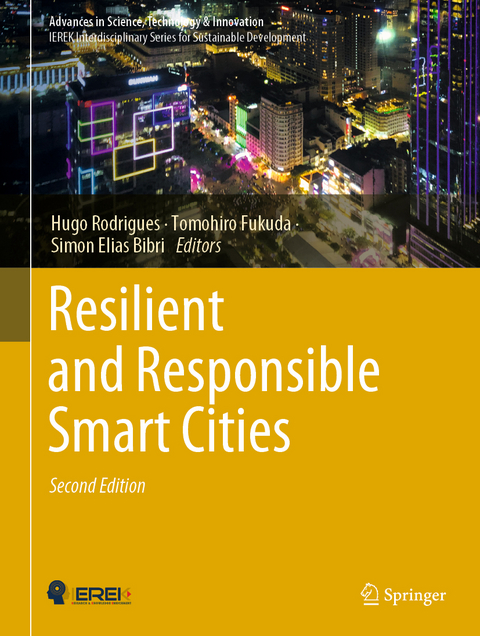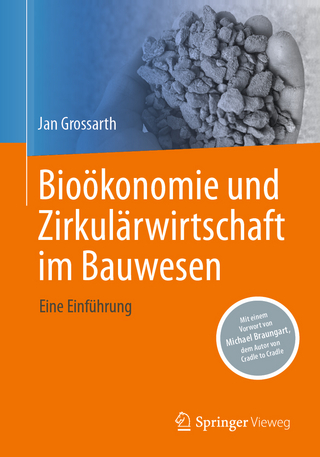
Resilient and Responsible Smart Cities
Springer International Publishing (Verlag)
978-3-030-98422-9 (ISBN)
This book gathers current research studies which explore new technologies in architecture and urban practices which ensure the efficient management of cities' infrastructures and provide new solutions to the complex complications that may result in the tackling of challenges of population density, traffic planning, and city planning at the neighborhood scale or rather the scale of buildings and everyday life. It offers a path towards city resilience and sustainable infrastructure with the aim of meeting the demands of mega-cities. The primary audience of this book will be academics and professionals from the fields of architecture, urban planning, civil engineering, computer sciences, and mathematics. The book will aid them in their contributions to the implementation of sustainable development goals.
lt;p>Hugo Rodrigues is Associate Professor in the Civil Engineering Department at the University of Aveiro. He received his Ph.D. in Civil Engineering from the University of Aveiro in 2012. His experience in seismic analysis, having participated as a team member in research and development projects, specialized consultancy studies ordered by several public institutions and companies regarding the assessment of seismic risk. His major research interests are building rehabilitation, structural health monitoring, and seismic safety including experimental and numerical activities. He is Research Member of the Risks and Sustainability in Construction (RISCO). He has co-authored several publications in top-tier peer-reviewed journals national and international meetings.
Dr. Tomohiro Fukuda is Associate Professor in the Division of Sustainable Energy and Environmental Engineering, Graduate School of Engineering, Osaka University, Japan. He obtained his Ph.D. (1999), M.E. (1996), and B.E. (1994) in environmental engineering at Osaka University. He worked for Matsushita Electric Works Co., Ltd. (Current: Panasonic Corporation) from 1996 to 2004 and then has been an associate professor at Osaka University since 2004.
He majors in environmental design and advanced information technology. His research interests are mainly environmental design and engineering, design support, computer-aided architectural design, spatial informatics and science, and media architecture. Especially, he has developed environmental design support methods using virtual, augmented and mixed reality (VR/AR/MR), 3-dimensional modeling, CFD (Computational Fluid Dynamics), BIM (Building Information Modeling), and AI (Artificial Intelligence). He has applied his developed methods to actual design projects such as Patio Design in Takamatsu Japan (2005-07), Next Gene 21+ in Taiwan (2007-08), VR Azuchi Castle in Omihachiman Japan (2011-15), and Mizuki Shigeru Road Renewal in Sakaiminato Japan (2016-18).
He is a former president of CAADRIA (the association of Computer Aided Architectural Design Research in Asia) and past representative of AIJ (Architectural Institute of Japan). He is a member of eCAADe (Education and research in Computer-Aided Architectural Design in Europe), JSCE (Japan Society of Civil Engineers), CPIJ (The City Planning Institute of Japan), etc. He has published over 200 journal and international conference papers and 13 books (collective writing). He was made a CAADRIA Fellow (2019) and won the best award of the Kobe lighting design competition (2001), etc.
Building a Smart City from the periphery to the center: Application of Technological solutions for intelligent integration of peripheral neighborhoods.- Accelerated community resettlement by the means of robotic 3d-printing from conflicted highway projects: A case study of Yaounde, Cameroon.- Design and Implementation of AMI System of Electric and Water Meter.- Low-cost sensor node for air quality monitoring: verification of NO2 measurements against a commercial system.- Exploring The Relationship of India's Residential and Commercial Infrastructure Through Land Value.- A Conceptual Framework to Manage Social Risks for Smart City Development Programs.- Intelligent Irrigation System for Future Smart City.- Cities in the Era of Autonomous Vehicles: A Comparison Be-tween Conventional Vehicles and Autonomous Vehicles.- The need for Soft Infrastructure in a delta megacity.- Energy-Efficient Automatic Light Control System For Modern Urban City.- Photo-voice as Means to Experience Water Space: Exploring Traditional Water Knowledge in Khulna, Bangladesh.- Assessing the Urban Form of Hill Settlements, New-Shimla, India Using 3D GIS Tools.
| Erscheinungsdatum | 24.07.2022 |
|---|---|
| Reihe/Serie | Advances in Science, Technology & Innovation |
| Zusatzinfo | XIV, 168 p. 140 illus., 118 illus. in color. |
| Verlagsort | Cham |
| Sprache | englisch |
| Maße | 210 x 279 mm |
| Gewicht | 645 g |
| Themenwelt | Naturwissenschaften ► Biologie ► Ökologie / Naturschutz |
| Sozialwissenschaften | |
| Technik ► Architektur | |
| Schlagworte | Information and Communication Technologies • Resilience • Responsibility in Architecture • smart cities • sustainability • urbanization |
| ISBN-10 | 3-030-98422-2 / 3030984222 |
| ISBN-13 | 978-3-030-98422-9 / 9783030984229 |
| Zustand | Neuware |
| Haben Sie eine Frage zum Produkt? |
aus dem Bereich


